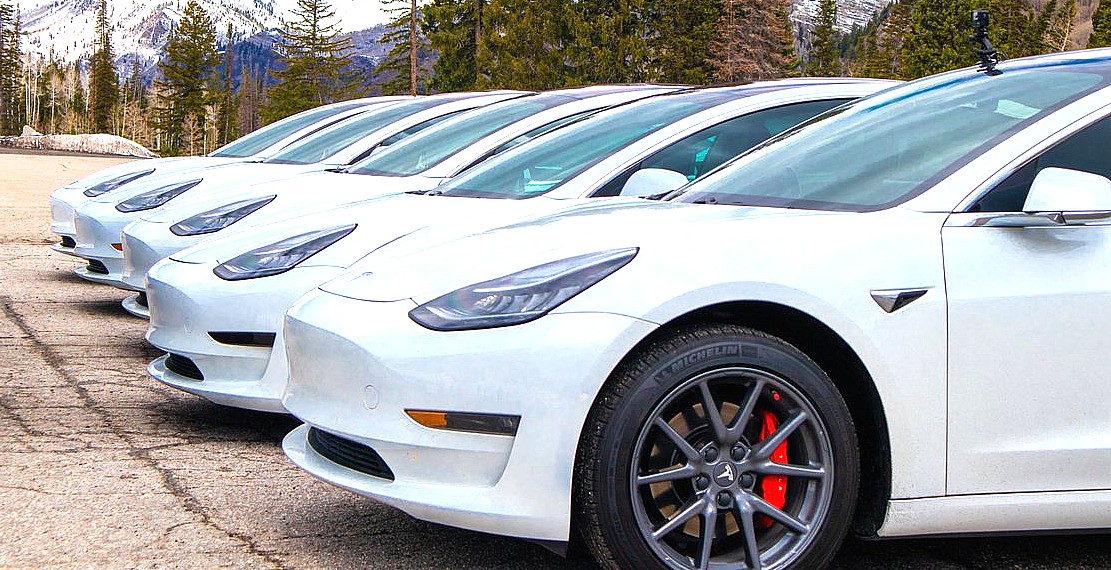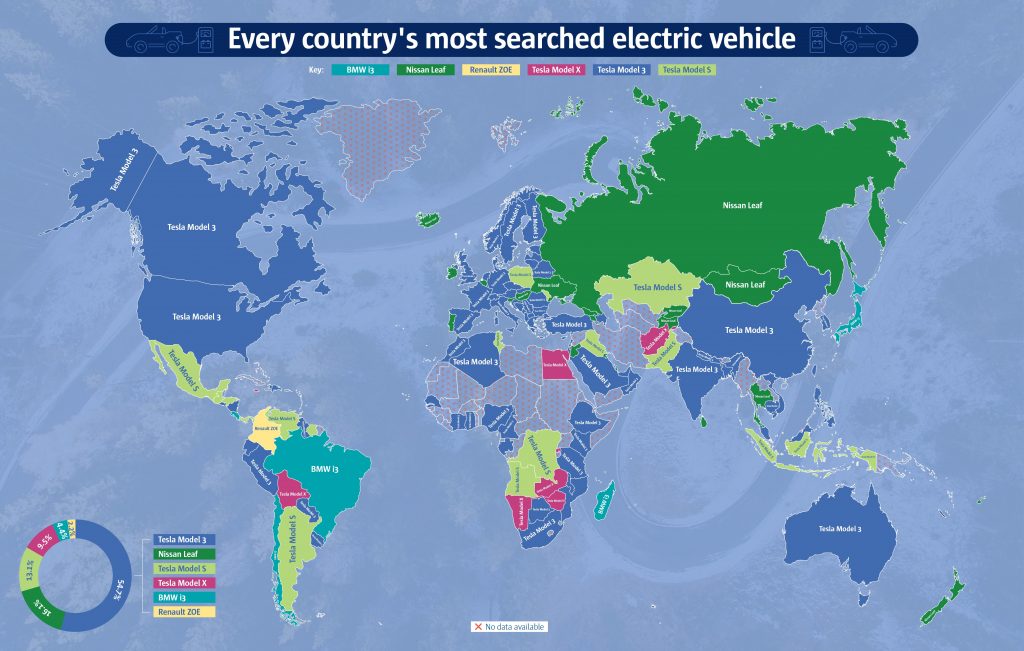

News
Tesla Model 3 tops survey for the world’s most searched-for electric car
A recent study from a Compare the Market, a UK-based price comparison company, has determined that the Tesla Model 3 is currently the world’s most searched-for all-electric vehicle in the world. Following behind the Model 3 was longtime EV veteran Nissan Leaf, as well as Tesla’s two other cars, the Model S and the Model X.
The UK-based firm’s study utilized Google search data to determine the most popular search term for each electric vehicle on the market and compare each car’s popularity across the globe. The survey’s figures are exclusive only to searches of battery-electric cars, as hybrids, plug-in hybrids, and hydrogen vehicles like the Toyota Mirai were not included in the survey.
According to Compare the Market’s results, the Tesla Model 3 is the overwhelming winner worldwide, being the most-searched-for EV in 54.7% of search traffic surveyed. That accounts for more than half of the 136 countries covered in the study. It should be noted that the gap between the Model 3 and the study’s second placer, the Nissan Leaf, was notable as well, with the Japanese-made EV leading in 16.1%, or 22 countries across the globe.

The Tesla Model S and Model X were the study’s 3rd and 4th placers, leading the rankings in 13.1% and 9.5%, taking of the search traffic surveyed. Overall, Tesla’s electric car lineup dominates internet searches for all-electric vehicles in 77.3% of the countries surveyed by the UK-based firm.
Apart from the Nissan Leaf, other non-Tesla vehicles that proved popular in Google searches were the BMW i3 (4.4%), and the Renault Zoe (2.2%). Other premium EVs such as the Jaguar I-PACE, the Audi e-tron, and the Mercedes EQC did not rank in the survey.
The study’s results become quite interesting when they are broken down by country. The Model 3 held a clean lead in a number of the world’s key auto markets, such as the United States, China, most of Europe, and even India, a country that is yet to see its first Tesla store. The Nissan Leaf dominated in Russia, while the Tesla Model S received the most search traffic from Mexico and Argentina. The BMW i3 even proved particularly popular in Brazil.
Interestingly, the study shows that the rankings didn’t necessarily align with the national origins of a particular vehicle. In Japan, for example, it was the BMW i3, a German car, that dominated internet searches. Germany, the home of the BMW i3, displayed strong interest for an American all-electric car, the Tesla Model 3.
Considering the hype and the close news coverage that follows Tesla’s electric car lineup, it is rather unsurprising to see the Model 3 dominating in the UK-based firm’s study. What is particularly notable was that even with the Model 3 taking most of the spotlight, Tesla’s Model S and Model X, which have already been in the market for years, ranked highly in the survey nonetheless. This shows that Tesla has become a brand that is perceived as a premier maker of EVs across the globe, even in areas where it is yet to begin selling its vehicles.
Part of Tesla’s secret sauce for its vehicles’ popularity lies in the company’s strong online presence, which it grows through organic engagement in social media. This was highlighted by a study from competitive intelligence analysis firm BrandTotal, which noted that Tesla, despite investing $0 in paid advertising on social media platforms, is the car company with the strongest social media presence. “Strong brands are able to command high engagement even without a robust digital ad spend. In Tesla’s case, we see their engagement numbers are high compared to other auto brands allocating spend in their digital campaigns,” Alon Leibovich, co-founder & CEO of BrandTotal, said.

Elon Musk
Elon Musk and Tesla AI Director share insights after empty driver seat Robotaxi rides
The executives’ unoccupied tests hint at the rapid progress of Tesla’s unsupervised Robotaxi efforts.

Tesla CEO Elon Musk and AI Director Ashok Elluswamy celebrated Christmas Eve by sharing personal experiences with Robotaxi vehicles that had no safety monitor or occupant in the driver’s seat. Musk described the system’s “perfect driving” around Austin, while Elluswamy posted video from the back seat, calling it “an amazing experience.”
The executives’ unoccupied tests hint at the rapid progress of Tesla’s unsupervised Robotaxi efforts.
Elon and Ashok’s firsthand Robotaxi insights
Prior to Musk and the Tesla AI Director’s posts, sightings of unmanned Teslas navigating public roads were widely shared on social media. One such vehicle was spotted in Austin, Texas, which Elon Musk acknowleged by stating that “Testing is underway with no occupants in the car.”
Based on his Christmas Eve post, Musk seemed to have tested an unmanned Tesla himself. “A Tesla with no safety monitor in the car and me sitting in the passenger seat took me all around Austin on Sunday with perfect driving,” Musk wrote in his post.
Elluswamy responded with a 2-minute video showing himself in the rear of an unmanned Tesla. The video featured the vehicle’s empty front seats, as well as its smooth handling through real-world traffic. He captioned his video with the words, “It’s an amazing experience!”
Towards Unsupervised operations
During an xAI Hackathon earlier this month, Elon Musk mentioned that Tesla owed be removing Safety Monitors from its Robotaxis in Austin in just three weeks. “Unsupervised is pretty much solved at this point. So there will be Tesla Robotaxis operating in Austin with no one in them. Not even anyone in the passenger seat in about three weeks,” he said. Musk echoed similar estimates at the 2025 Annual Shareholder Meeting and the Q3 2025 earnings call.
Considering the insights that were posted Musk and Elluswamy, it does appear that Tesla is working hard towards operating its Robotaxis with no safety monitors. This is quite impressive considering that the service was launched just earlier this year.
Elon Musk
Starlink passes 9 million active customers just weeks after hitting 8 million
The milestone highlights the accelerating growth of Starlink, which has now been adding over 20,000 new users per day.

SpaceX’s Starlink satellite internet service has continued its rapid global expansion, surpassing 9 million active customers just weeks after crossing the 8 million mark.
The milestone highlights the accelerating growth of Starlink, which has now been adding over 20,000 new users per day.
9 million customers
In a post on X, SpaceX stated that Starlink now serves over 9 million active users across 155 countries, territories, and markets. The company reached 8 million customers in early November, meaning it added roughly 1 million subscribers in under seven weeks, or about 21,275 new users on average per day.
“Starlink is connecting more than 9M active customers with high-speed internet across 155 countries, territories, and many other markets,” Starlink wrote in a post on its official X account. SpaceX President Gwynne Shotwell also celebrated the milestone on X. “A huge thank you to all of our customers and congrats to the Starlink team for such an incredible product,” she wrote.
That growth rate reflects both rising demand for broadband in underserved regions and Starlink’s expanding satellite constellation, which now includes more than 9,000 low-Earth-orbit satellites designed to deliver high-speed, low-latency internet worldwide.
Starlink’s momentum
Starlink’s momentum has been building up. SpaceX reported 4.6 million Starlink customers in December 2024, followed by 7 million by August 2025, and 8 million customers in November. Independent data also suggests Starlink usage is rising sharply, with Cloudflare reporting that global web traffic from Starlink users more than doubled in 2025, as noted in an Insider report.
Starlink’s momentum is increasingly tied to SpaceX’s broader financial outlook. Elon Musk has said the satellite network is “by far” the company’s largest revenue driver, and reports suggest SpaceX may be positioning itself for an initial public offering as soon as next year, with valuations estimated as high as $1.5 trillion. Musk has also suggested in the past that Starlink could have its own IPO in the future.
News
NVIDIA Director of Robotics: Tesla FSD v14 is the first AI to pass the “Physical Turing Test”
After testing FSD v14, Fan stated that his experience with FSD felt magical at first, but it soon started to feel like a routine.

NVIDIA Director of Robotics Jim Fan has praised Tesla’s Full Self-Driving (Supervised) v14 as the first AI to pass what he described as a “Physical Turing Test.”
After testing FSD v14, Fan stated that his experience with FSD felt magical at first, but it soon started to feel like a routine. And just like smartphones today, removing it now would “actively hurt.”
Jim Fan’s hands-on FSD v14 impressions
Fan, a leading researcher in embodied AI who is currently solving Physical AI at NVIDIA and spearheading the company’s Project GR00T initiative, noted that he actually was late to the Tesla game. He was, however, one of the first to try out FSD v14.
“I was very late to own a Tesla but among the earliest to try out FSD v14. It’s perhaps the first time I experience an AI that passes the Physical Turing Test: after a long day at work, you press a button, lay back, and couldn’t tell if a neural net or a human drove you home,” Fan wrote in a post on X.
Fan added: “Despite knowing exactly how robot learning works, I still find it magical watching the steering wheel turn by itself. First it feels surreal, next it becomes routine. Then, like the smartphone, taking it away actively hurts. This is how humanity gets rewired and glued to god-like technologies.”
The Physical Turing Test
The original Turing Test was conceived by Alan Turing in 1950, and it was aimed at determining if a machine could exhibit behavior that is equivalent to or indistinguishable from a human. By focusing on text-based conversations, the original Turing Test set a high bar for natural language processing and machine learning.
This test has been passed by today’s large language models. However, the capability to converse in a humanlike manner is a completely different challenge from performing real-world problem-solving or physical interactions. Thus, Fan introduced the Physical Turing Test, which challenges AI systems to demonstrate intelligence through physical actions.
Based on Fan’s comments, Tesla has demonstrated these intelligent physical actions with FSD v14. Elon Musk agreed with the NVIDIA executive, stating in a post on X that with FSD v14, “you can sense the sentience maturing.” Musk also praised Tesla AI, calling it the best “real-world AI” today.








